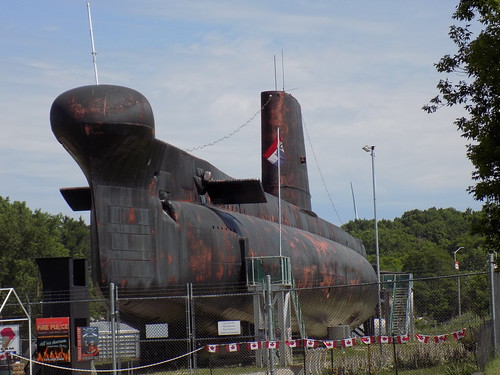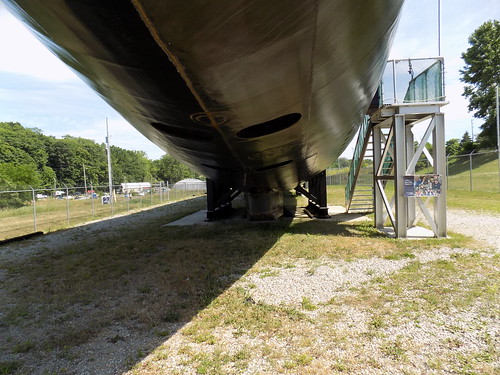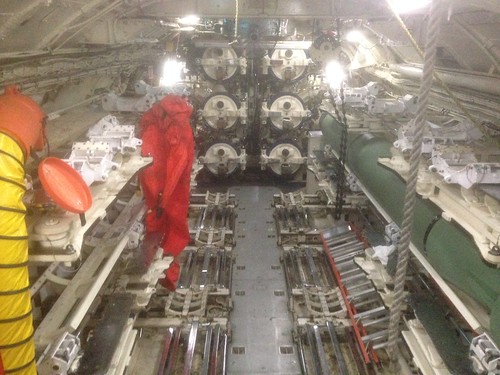As you guys know I am very fond of North America & Canada and I have the intention of making a permanent home in the latter.
Well in the great Province of Ontario there are two items on my agenda which despite my frequent trips I have only now managed to go and see.

First up is a treasure in her own right the submarine HMCS Ojibwa located at Port Burwell, the submarine herself is currently on the outside anyway looking like she is in a bit of disrepair however I am reliably informed she is due to be repainted shortly, the reason she is in a state is when the boat was being sold off the Navy wanted the sonar absorbing paint stripped off originally she was headed for scrap but was saved.
You get a sense of size with this submarine that you don’t get with others such as HMS Ocelot (Same class) maybe because it is on dry land where as Ocelot sit in a dry dock but there is one thing to notice and it does stick out like a sore thumb she has substantial damage to her port side saddle tanks, not by lifting her out of the water or dropping her but before she was tendered for scrap she took part in explosive tests which caused the damage and so it remains.

Originally laid down in 1962 as the HMS Onyx she was sold to Canada while still under construction and named after the first nation peoples, she would enter service with the Canadian navy Atlantic fleet in 1965 and be put straight to work.
During her construction she was built to Royal Navy standards one was to tell this is by the hatch design in the Bulkheads, British hatches are perfectly round while North American hatches are oval, over time with refits her layout changed and she is radically different to the British submarines of the same class and indeed each of the Canadian submarines are different again, one notable feature is a small medical ward in the officers mess something the British boats never had.
HMCS Ojibwa would see action throughout the cold war and she would take part in many exercises and also go on to track soviet submarines, in 1985 the Ojibwa while conducting an Anti-Submarine patrol for NATO discovered a Soviet Delta class submarine which passed by very close to the Ojibwa, while in the track she was discovered by a soviet victor class attack submarine and she broke contact with both after two days.
With the end of the cold war came a new role this time with the department for oceans & fisheries which led to the eventual “Turbot war” between the EU (Chiefly Spain) and Canada with Canada coming out on top after a deal was reached.
Now entering into the 1990’s the Ojibwa was showing her age the former and paid off Oberon class submarine HMS Osiris was purchased as a hulk and used for spare parts, with the Royal navy now entering its long decline and rapid cut backs all the Oberon class submarines were removed from service by the early 1990’s in the Royal navy but the Canadian, Chilean, Australian and Brazilian boats soldiered on, during this time Ojibwa would enter her final refit where she would be cut in two and her engines replaced with the newer ones of the former HMS Osiris.
This action would extend her life with the above mentioned cuts to the Royal Navy the planned 12 Upholder class submarines were never built only 4 made completion and promptly after a few years’ service paid off and were now laid up pending sale or disposal.
With an ageing fleet of submarines it was time for replacement sensing a bargain and the relatively young age of the Upholders Canada bought all 4 and thus was born the Victoria class which serve today (despite the initial problems).

[/url]
DSCN1212 by
B S, on Flickr
HMCS Ojibwa would pay off in 1998 after 34 years’ service with the Canadian navy being replaced by the former Upholders, she would have just one final duty to perform as an experiment.
After sitting idle for sometime she was towed out to sea a large under water charge placed relatively close to her (some 200-300 yards away) and detonated, this was to see the effects of underwater explosions on hulls, the damage is significant and is still visible today.
She was towed back to port where she was to wait her final fate which was likely the scrappers.
However in 2012 she was sold as a museum ship and towed to Port Burwell where she was lifted onto land and finally in 2013 opened to the public, she remains at her current site however due to the technology on board it is forbidden to take pictures of her interior past the torpedo room a bit disappointing but her entire layout is worth the look around the guided tour is very interesting and they do know their stuff a worthwhile visit if your passing through.
